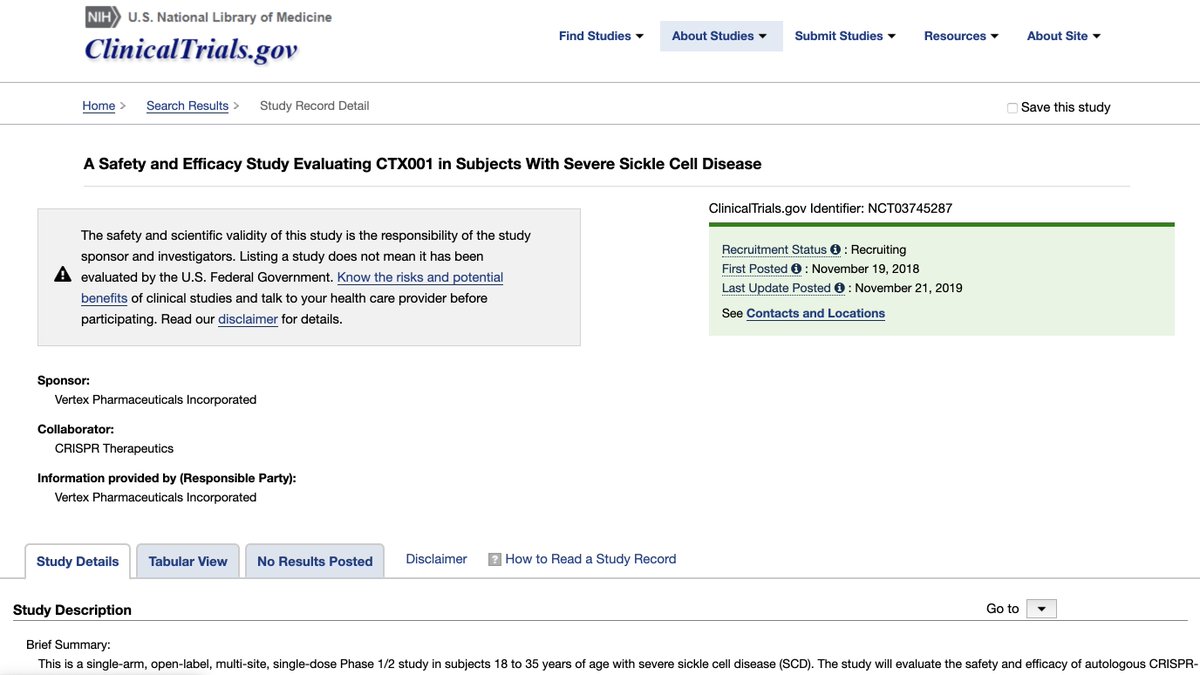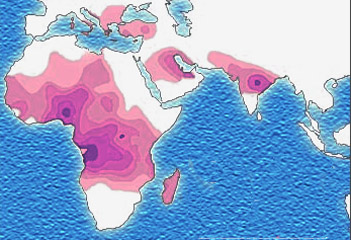Today is Thanksgiving in the U.S.—in the spirit of the holiday, I want to focus on a positive story about CRISPR, instead of the misadventures of He Jiankui:
“How CRISPR + GWAS (May Have) Cured Sickle Cell Disease”
Surely a story about which to be thankful. (thread) https://twitter.com/kiranmusunuru/status/1199651783708225537">https://twitter.com/kiranmusu...
“How CRISPR + GWAS (May Have) Cured Sickle Cell Disease”
Surely a story about which to be thankful. (thread) https://twitter.com/kiranmusunuru/status/1199651783708225537">https://twitter.com/kiranmusu...
2/
#SickleCell disease (SCD), devastating for millions and most prevalent in sub-Saharan Africa, is caused by abnormal adult hemoglobin (HbS) deforming red blood cells.
Fetal hemoglobin (HbF) functions similarly to normal adult hemoglobin.
But HbF levels fall soon after birth.
#SickleCell disease (SCD), devastating for millions and most prevalent in sub-Saharan Africa, is caused by abnormal adult hemoglobin (HbS) deforming red blood cells.
Fetal hemoglobin (HbF) functions similarly to normal adult hemoglobin.
But HbF levels fall soon after birth.
3/
Increased HbF improves SCD—the mechanism for SCD drug hydroxyurea.
Researchers asked if some people have genetic variants increasing HbF.
Common variant studies—genome-wide association studies (GWAS)—were more fruitful than rare variant studies.
H/t @skathire for figure.
Increased HbF improves SCD—the mechanism for SCD drug hydroxyurea.
Researchers asked if some people have genetic variants increasing HbF.
Common variant studies—genome-wide association studies (GWAS)—were more fruitful than rare variant studies.
H/t @skathire for figure.
4/
In parallel work in 2007/8, Thein & team and Orkin, Cao & team studied the St. Thomas Adult Twin Registry and a cohort of Sardinians: GWAS with adults with the highest vs. lowest HbF.
Novel association: BCL11A locus and HbF.
https://www.ncbi.nlm.nih.gov/pubmed/17767159
https://www.ncbi.nlm.nih.gov/pubmed/17... href=" https://www.ncbi.nlm.nih.gov/pubmed/18245381 ">https://www.ncbi.nlm.nih.gov/pubmed/18...
In parallel work in 2007/8, Thein & team and Orkin, Cao & team studied the St. Thomas Adult Twin Registry and a cohort of Sardinians: GWAS with adults with the highest vs. lowest HbF.
Novel association: BCL11A locus and HbF.
https://www.ncbi.nlm.nih.gov/pubmed/17767159
5/
In 2008, @GLettre, @bloodgenes, @joelhirschhorn, Orkin & team reported that common variants in the BCL11A locus associate with HbF levels and *severity of disease* in SCD patients.
https://www.ncbi.nlm.nih.gov/pubmed/18667698 ">https://www.ncbi.nlm.nih.gov/pubmed/18...
In 2008, @GLettre, @bloodgenes, @joelhirschhorn, Orkin & team reported that common variants in the BCL11A locus associate with HbF levels and *severity of disease* in SCD patients.
https://www.ncbi.nlm.nih.gov/pubmed/18667698 ">https://www.ncbi.nlm.nih.gov/pubmed/18...
6/
In 2008/9, @bloodgenes, Xu, Orkin & team showed in elegant studies in human cells and mice that BCL11A is responsible for silencing HbF and switching to adult hemoglobin in red blood cells after birth.
https://www.ncbi.nlm.nih.gov/pubmed/19056937
https://www.ncbi.nlm.nih.gov/pubmed/19... href=" https://www.ncbi.nlm.nih.gov/pubmed/19657335 ">https://www.ncbi.nlm.nih.gov/pubmed/19...
In 2008/9, @bloodgenes, Xu, Orkin & team showed in elegant studies in human cells and mice that BCL11A is responsible for silencing HbF and switching to adult hemoglobin in red blood cells after birth.
https://www.ncbi.nlm.nih.gov/pubmed/19056937
7/
In 2011, Xu (of @JianXuLab), Orkin & team found in a mouse model of SCD that inactivation of BCL11A in the erythroid (red blood cell) lineage corrected the disease.
This opened the door to varied strategies to inactivate BCL11A to treat SCD patients.
https://www.ncbi.nlm.nih.gov/pubmed/21998251 ">https://www.ncbi.nlm.nih.gov/pubmed/21...
In 2011, Xu (of @JianXuLab), Orkin & team found in a mouse model of SCD that inactivation of BCL11A in the erythroid (red blood cell) lineage corrected the disease.
This opened the door to varied strategies to inactivate BCL11A to treat SCD patients.
https://www.ncbi.nlm.nih.gov/pubmed/21998251 ">https://www.ncbi.nlm.nih.gov/pubmed/21...
8/
In 2013-2015, @danielevanbauer, Orkin & team used genetics, TALENs, and then CRISPR to map the BCL11A locus, identifying an erythroid enhancer that, when edited, resulted in less BCL11A + more HbF.
Next step: CRISPR therapy.
https://www.ncbi.nlm.nih.gov/pubmed/24115442
https://www.ncbi.nlm.nih.gov/pubmed/24... href=" https://www.ncbi.nlm.nih.gov/pubmed/26375006 ">https://www.ncbi.nlm.nih.gov/pubmed/26...
In 2013-2015, @danielevanbauer, Orkin & team used genetics, TALENs, and then CRISPR to map the BCL11A locus, identifying an erythroid enhancer that, when edited, resulted in less BCL11A + more HbF.
Next step: CRISPR therapy.
https://www.ncbi.nlm.nih.gov/pubmed/24115442
9/
$VRTX and $CRSP have developed a CRISPR therapy—CTX001—that edits the BCL11A erythroid enhancer in bone marrow stem cells of patients with SCD or beta thalassemia (another blood disorder in which increased HbF is beneficial).
https://clinicaltrials.gov/ct2/show/NCT03745287">https://clinicaltrials.gov/ct2/show/...
$VRTX and $CRSP have developed a CRISPR therapy—CTX001—that edits the BCL11A erythroid enhancer in bone marrow stem cells of patients with SCD or beta thalassemia (another blood disorder in which increased HbF is beneficial).
https://clinicaltrials.gov/ct2/show/NCT03745287">https://clinicaltrials.gov/ct2/show/...
10/
Earlier this year, two patients—one with SCD, one with beta thalassemia—received the CRISPR therapy.
Last week, we learned that both patients have had dramatic improvements in their health. So much so, the treatment might have been a full cure. https://twitter.com/sxbegle/status/1196778144822448128">https://twitter.com/sxbegle/s...
Earlier this year, two patients—one with SCD, one with beta thalassemia—received the CRISPR therapy.
Last week, we learned that both patients have had dramatic improvements in their health. So much so, the treatment might have been a full cure. https://twitter.com/sxbegle/status/1196778144822448128">https://twitter.com/sxbegle/s...
11/
The SCD patient who received the CRISPR therapy had her HbF level surge to ≈50% of total hemoglobin and has had no disease attacks since. The other patient had her HbF rise to almost 100%.
I don’t think I’m exaggerating when I say this is stunning. https://twitter.com/NPR/status/1196902482858926081">https://twitter.com/NPR/statu...
The SCD patient who received the CRISPR therapy had her HbF level surge to ≈50% of total hemoglobin and has had no disease attacks since. The other patient had her HbF rise to almost 100%.
I don’t think I’m exaggerating when I say this is stunning. https://twitter.com/NPR/status/1196902482858926081">https://twitter.com/NPR/statu...
12/
This is just the beginning. There are a variety of additional viable strategies to genetically treat SCD, including RNA interference to knock down BCL11A. https://twitter.com/AndyBiotech/status/1197520820769361921">https://twitter.com/AndyBiote...
This is just the beginning. There are a variety of additional viable strategies to genetically treat SCD, including RNA interference to knock down BCL11A. https://twitter.com/AndyBiotech/status/1197520820769361921">https://twitter.com/AndyBiote...
13/
There are vocal detractors who bemoan the “billions” in taxpayer money spent on GWAS.
Yes, it was a lot of money.
But even if all that comes from it is a cure for sickle cell disease & beta thalassemia—IMHO that’s not so bad a return on investment.
https://www.ebi.ac.uk/gwas/diagram ">https://www.ebi.ac.uk/gwas/diag...
There are vocal detractors who bemoan the “billions” in taxpayer money spent on GWAS.
Yes, it was a lot of money.
But even if all that comes from it is a cure for sickle cell disease & beta thalassemia—IMHO that’s not so bad a return on investment.
https://www.ebi.ac.uk/gwas/diagram ">https://www.ebi.ac.uk/gwas/diag...
14/
There’s a happy irony that with the money mostly going to the genotyping of people of European ancestry, the biggest near-term impact of GWAS might actually be on the health of people of sub-Saharan African ancestry.
Map of sickle cell disease distribution:
There’s a happy irony that with the money mostly going to the genotyping of people of European ancestry, the biggest near-term impact of GWAS might actually be on the health of people of sub-Saharan African ancestry.
Map of sickle cell disease distribution:
15/
The CRISPR trial for #SickleCell is so late-breaking that I wasn’t able to include it in #TheCRISPRGeneration. On the list for the 2nd edition.
Next time, it’s back to He Jiankui: what was he hoping to achieve by editing CCR5, and did he succeed? https://twitter.com/kiranmusunuru/status/1198927090315345921">https://twitter.com/kiranmusu...
The CRISPR trial for #SickleCell is so late-breaking that I wasn’t able to include it in #TheCRISPRGeneration. On the list for the 2nd edition.
Next time, it’s back to He Jiankui: what was he hoping to achieve by editing CCR5, and did he succeed? https://twitter.com/kiranmusunuru/status/1198927090315345921">https://twitter.com/kiranmusu...

 Read on Twitter
Read on Twitter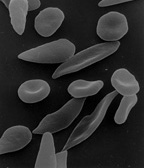
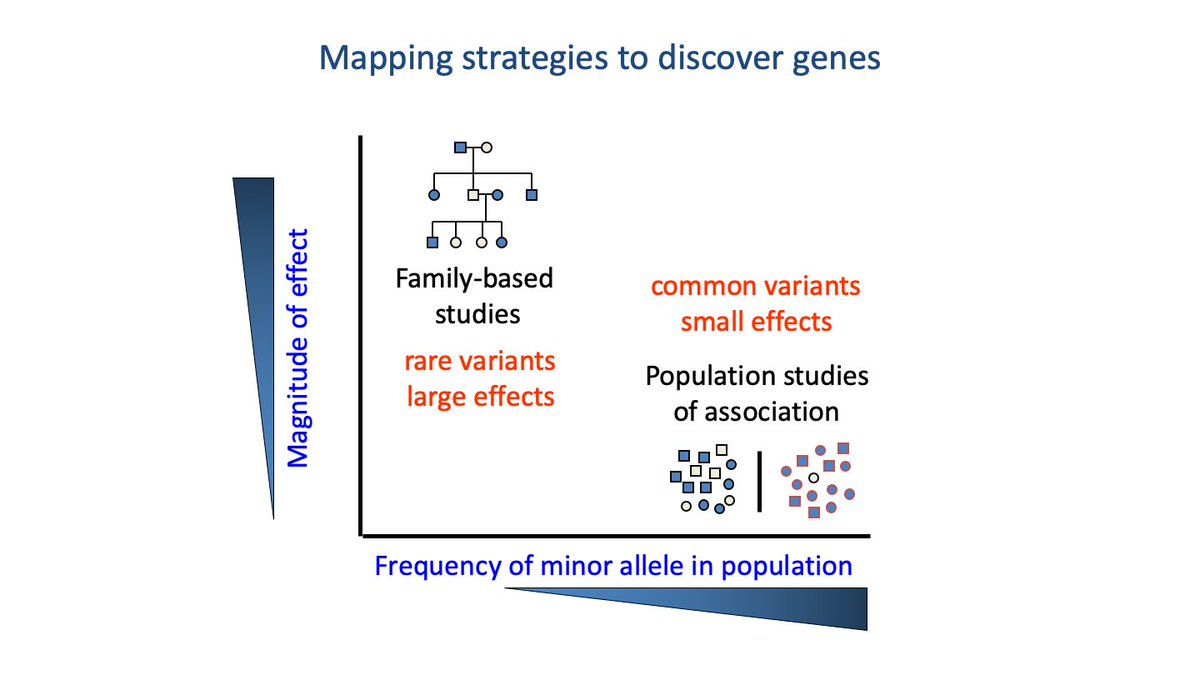
 https://www.ncbi.nlm.nih.gov/pubmed/18..." title="4/In parallel work in 2007/8, Thein & team and Orkin, Cao & team studied the St. Thomas Adult Twin Registry and a cohort of Sardinians: GWAS with adults with the highest vs. lowest HbF.Novel association: BCL11A locus and HbF. https://www.ncbi.nlm.nih.gov/pubmed/17... href=" https://www.ncbi.nlm.nih.gov/pubmed/18245381 ">https://www.ncbi.nlm.nih.gov/pubmed/18...">
https://www.ncbi.nlm.nih.gov/pubmed/18..." title="4/In parallel work in 2007/8, Thein & team and Orkin, Cao & team studied the St. Thomas Adult Twin Registry and a cohort of Sardinians: GWAS with adults with the highest vs. lowest HbF.Novel association: BCL11A locus and HbF. https://www.ncbi.nlm.nih.gov/pubmed/17... href=" https://www.ncbi.nlm.nih.gov/pubmed/18245381 ">https://www.ncbi.nlm.nih.gov/pubmed/18...">
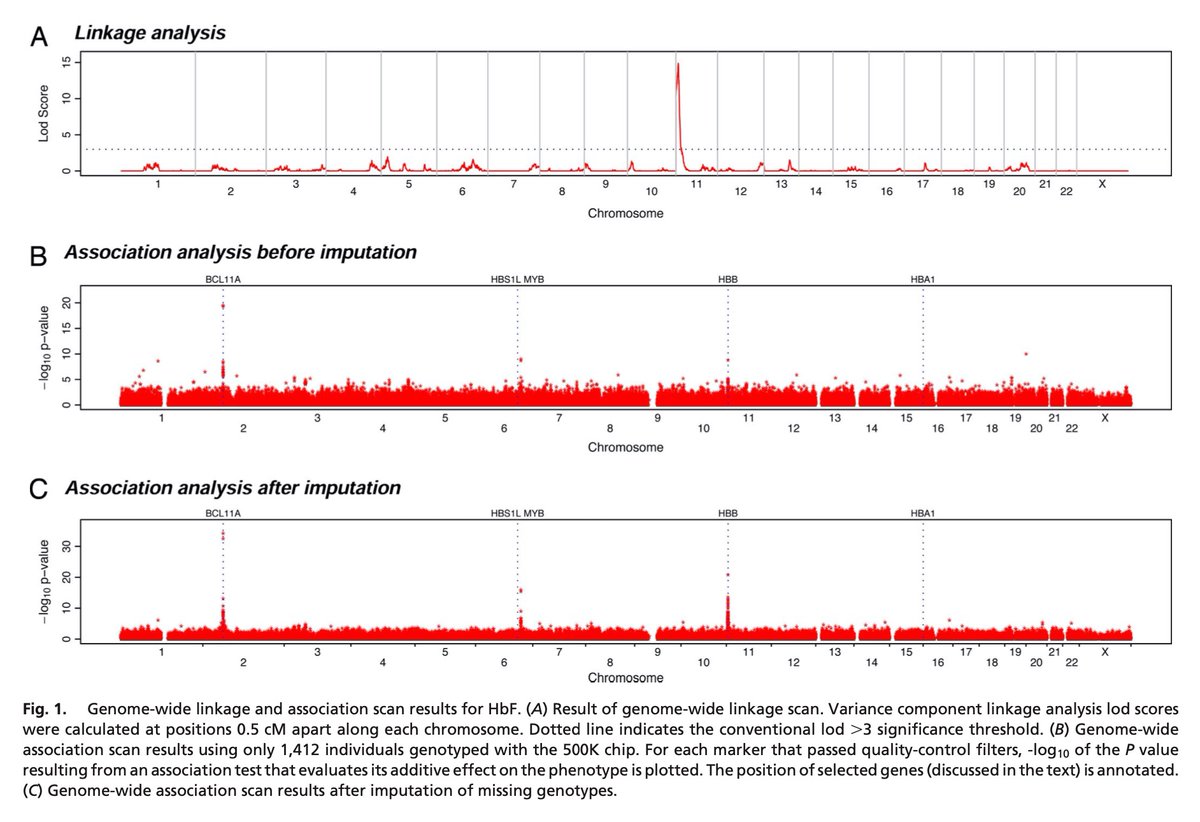 https://www.ncbi.nlm.nih.gov/pubmed/18..." title="4/In parallel work in 2007/8, Thein & team and Orkin, Cao & team studied the St. Thomas Adult Twin Registry and a cohort of Sardinians: GWAS with adults with the highest vs. lowest HbF.Novel association: BCL11A locus and HbF. https://www.ncbi.nlm.nih.gov/pubmed/17... href=" https://www.ncbi.nlm.nih.gov/pubmed/18245381 ">https://www.ncbi.nlm.nih.gov/pubmed/18...">
https://www.ncbi.nlm.nih.gov/pubmed/18..." title="4/In parallel work in 2007/8, Thein & team and Orkin, Cao & team studied the St. Thomas Adult Twin Registry and a cohort of Sardinians: GWAS with adults with the highest vs. lowest HbF.Novel association: BCL11A locus and HbF. https://www.ncbi.nlm.nih.gov/pubmed/17... href=" https://www.ncbi.nlm.nih.gov/pubmed/18245381 ">https://www.ncbi.nlm.nih.gov/pubmed/18...">
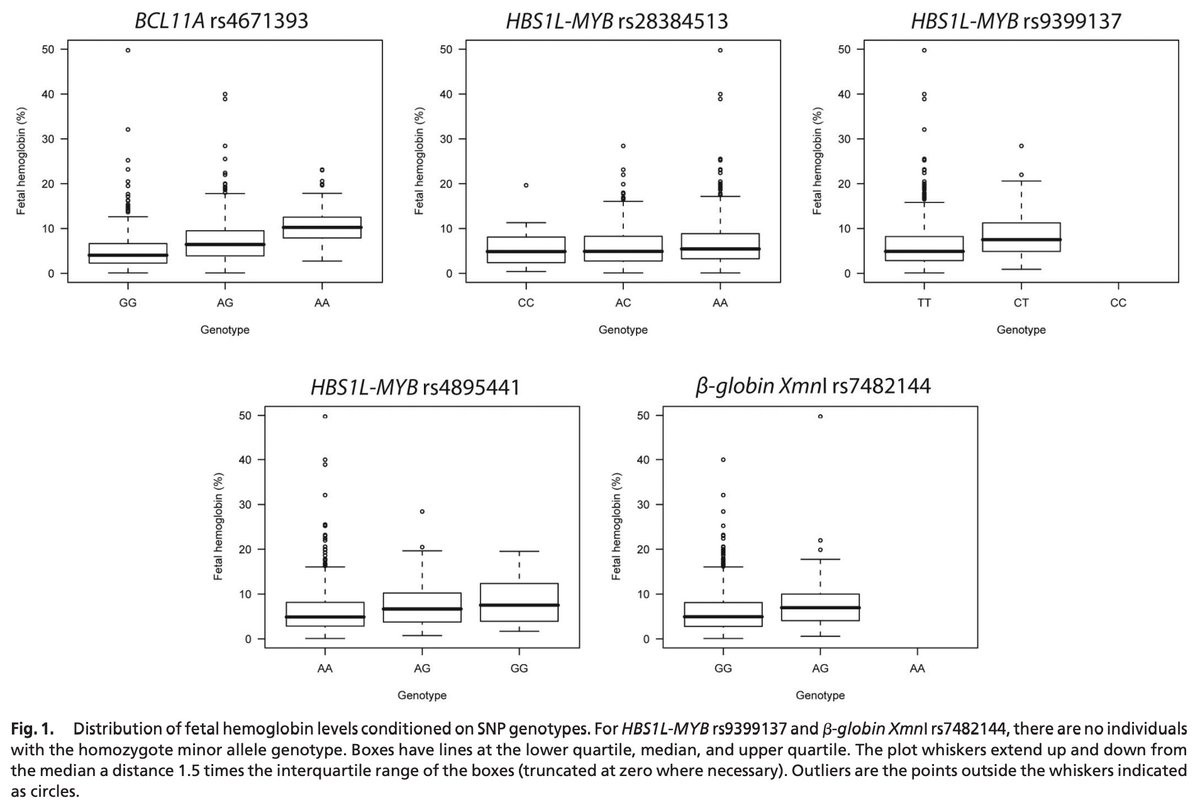
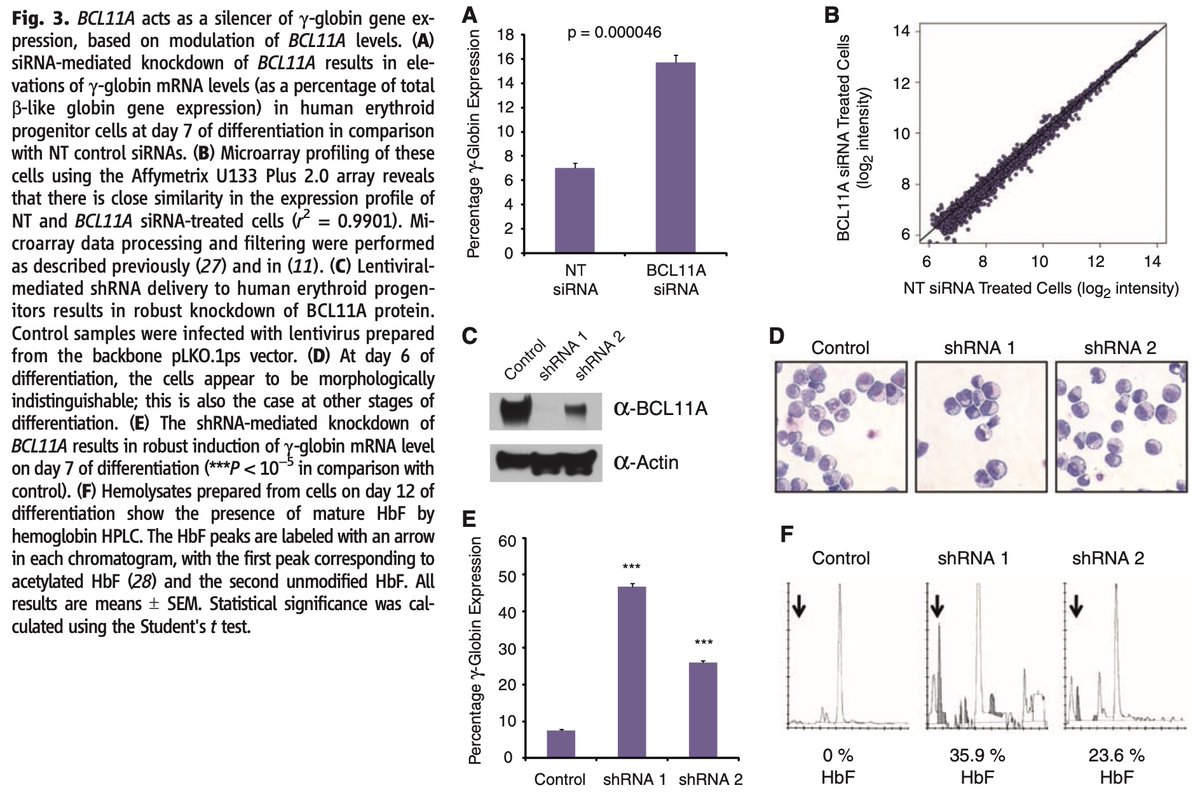 https://www.ncbi.nlm.nih.gov/pubmed/19..." title="6/In 2008/9, @bloodgenes, Xu, Orkin & team showed in elegant studies in human cells and mice that BCL11A is responsible for silencing HbF and switching to adult hemoglobin in red blood cells after birth. https://www.ncbi.nlm.nih.gov/pubmed/19... href=" https://www.ncbi.nlm.nih.gov/pubmed/19657335 ">https://www.ncbi.nlm.nih.gov/pubmed/19...">
https://www.ncbi.nlm.nih.gov/pubmed/19..." title="6/In 2008/9, @bloodgenes, Xu, Orkin & team showed in elegant studies in human cells and mice that BCL11A is responsible for silencing HbF and switching to adult hemoglobin in red blood cells after birth. https://www.ncbi.nlm.nih.gov/pubmed/19... href=" https://www.ncbi.nlm.nih.gov/pubmed/19657335 ">https://www.ncbi.nlm.nih.gov/pubmed/19...">
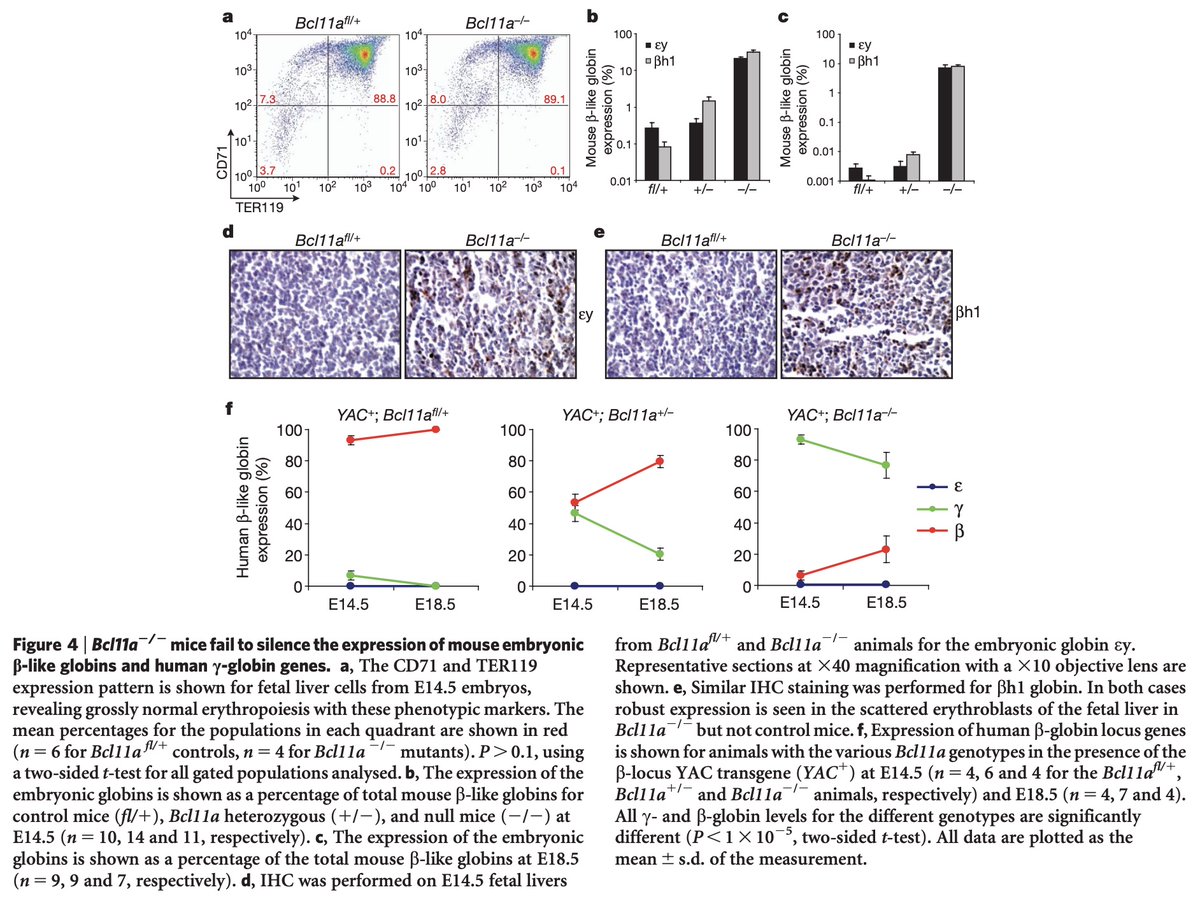 https://www.ncbi.nlm.nih.gov/pubmed/19..." title="6/In 2008/9, @bloodgenes, Xu, Orkin & team showed in elegant studies in human cells and mice that BCL11A is responsible for silencing HbF and switching to adult hemoglobin in red blood cells after birth. https://www.ncbi.nlm.nih.gov/pubmed/19... href=" https://www.ncbi.nlm.nih.gov/pubmed/19657335 ">https://www.ncbi.nlm.nih.gov/pubmed/19...">
https://www.ncbi.nlm.nih.gov/pubmed/19..." title="6/In 2008/9, @bloodgenes, Xu, Orkin & team showed in elegant studies in human cells and mice that BCL11A is responsible for silencing HbF and switching to adult hemoglobin in red blood cells after birth. https://www.ncbi.nlm.nih.gov/pubmed/19... href=" https://www.ncbi.nlm.nih.gov/pubmed/19657335 ">https://www.ncbi.nlm.nih.gov/pubmed/19...">
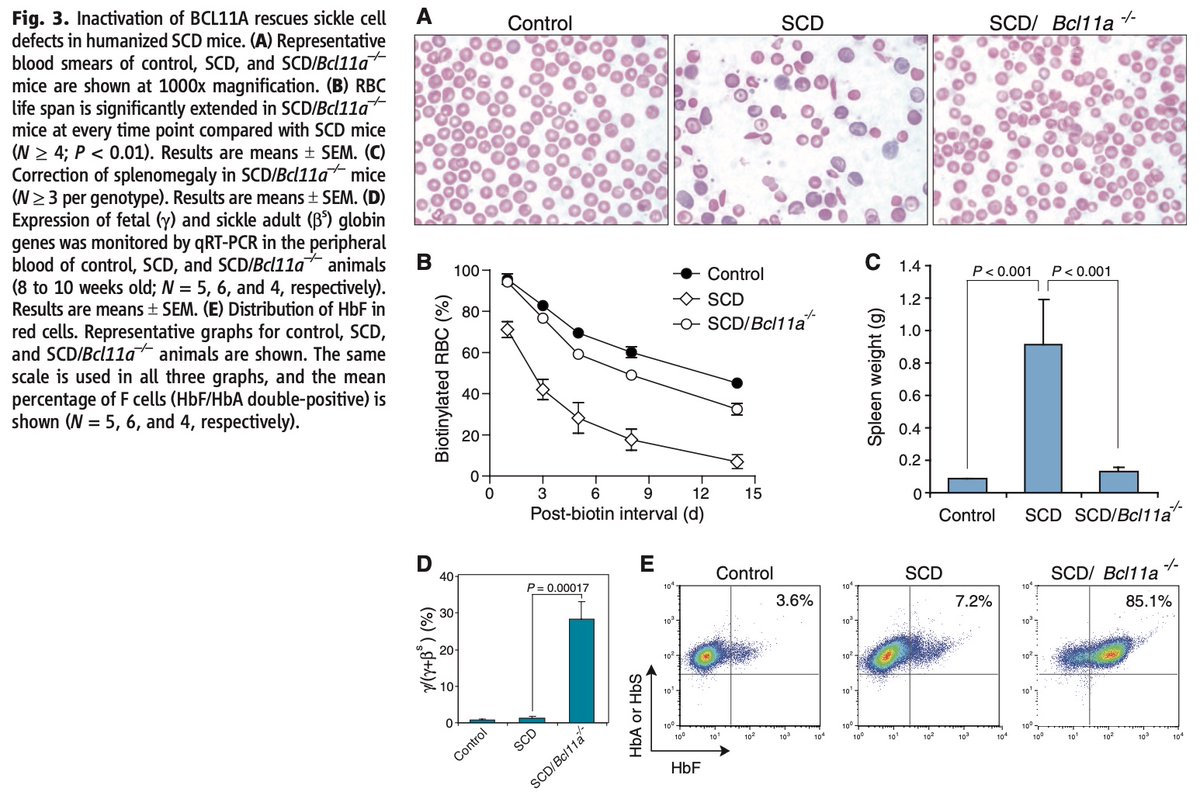
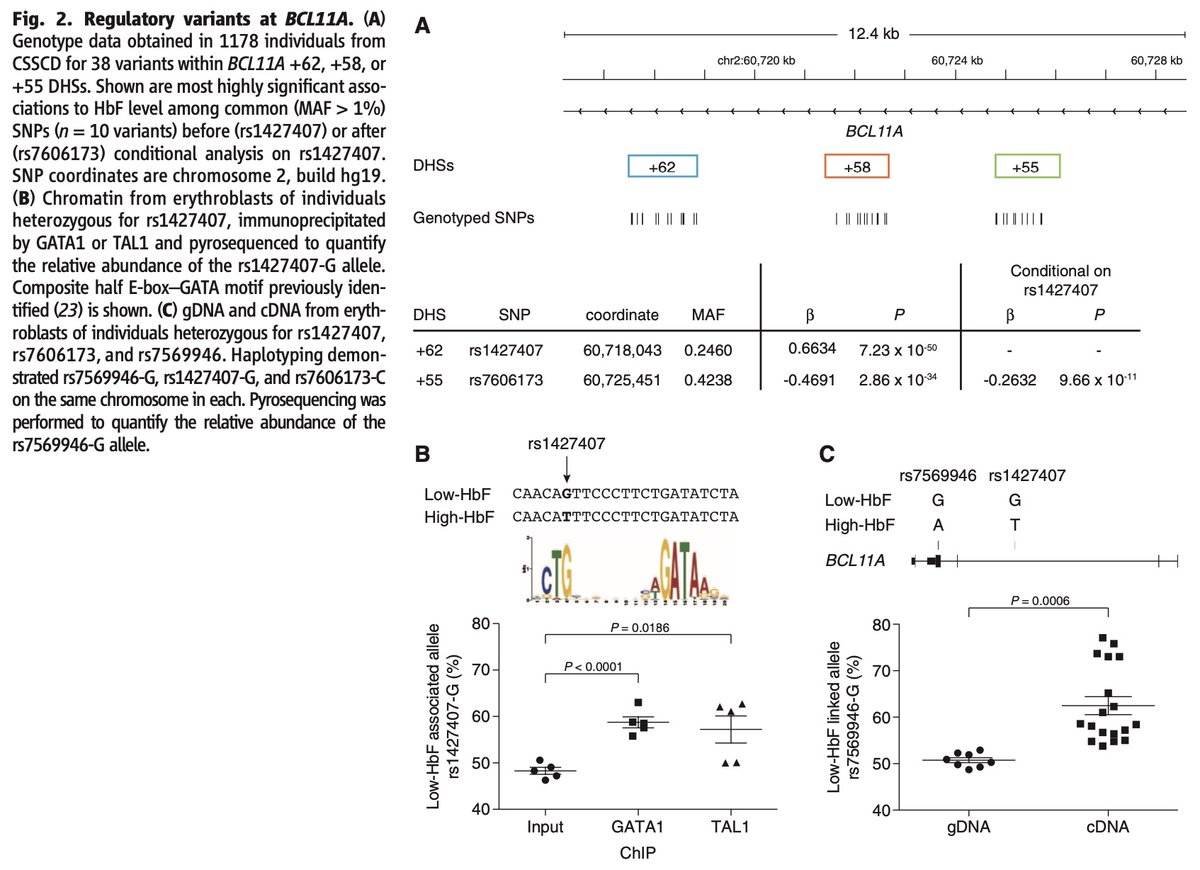 https://www.ncbi.nlm.nih.gov/pubmed/26..." title="8/In 2013-2015, @danielevanbauer, Orkin & team used genetics, TALENs, and then CRISPR to map the BCL11A locus, identifying an erythroid enhancer that, when edited, resulted in less BCL11A + more HbF.Next step: CRISPR therapy. https://www.ncbi.nlm.nih.gov/pubmed/24... href=" https://www.ncbi.nlm.nih.gov/pubmed/26375006 ">https://www.ncbi.nlm.nih.gov/pubmed/26...">
https://www.ncbi.nlm.nih.gov/pubmed/26..." title="8/In 2013-2015, @danielevanbauer, Orkin & team used genetics, TALENs, and then CRISPR to map the BCL11A locus, identifying an erythroid enhancer that, when edited, resulted in less BCL11A + more HbF.Next step: CRISPR therapy. https://www.ncbi.nlm.nih.gov/pubmed/24... href=" https://www.ncbi.nlm.nih.gov/pubmed/26375006 ">https://www.ncbi.nlm.nih.gov/pubmed/26...">
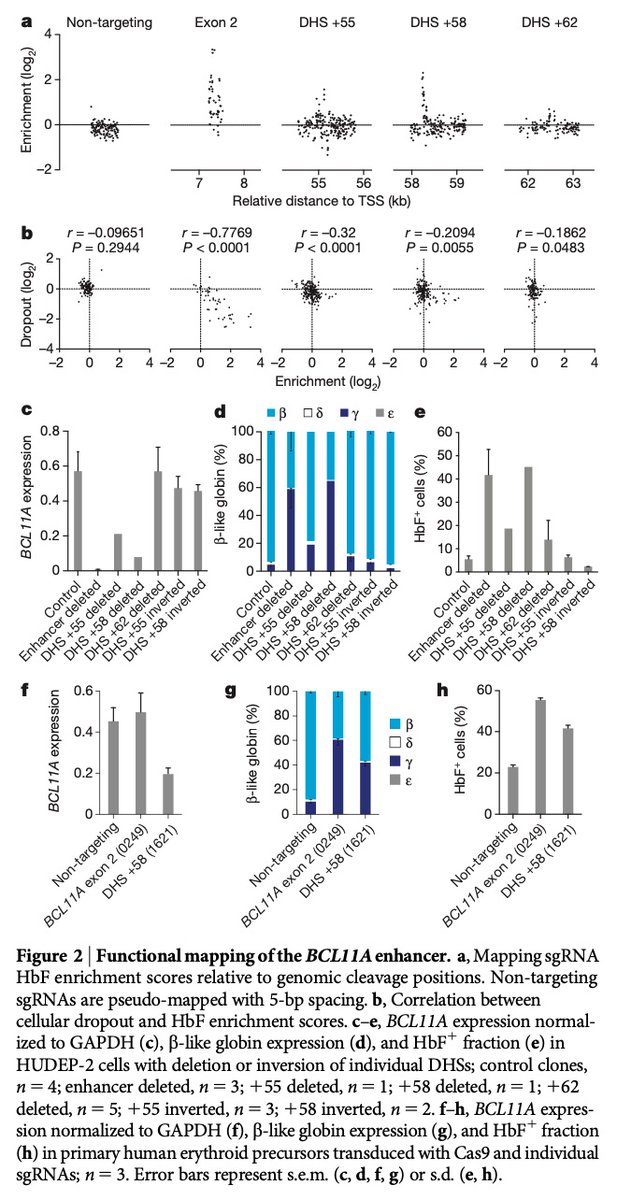 https://www.ncbi.nlm.nih.gov/pubmed/26..." title="8/In 2013-2015, @danielevanbauer, Orkin & team used genetics, TALENs, and then CRISPR to map the BCL11A locus, identifying an erythroid enhancer that, when edited, resulted in less BCL11A + more HbF.Next step: CRISPR therapy. https://www.ncbi.nlm.nih.gov/pubmed/24... href=" https://www.ncbi.nlm.nih.gov/pubmed/26375006 ">https://www.ncbi.nlm.nih.gov/pubmed/26...">
https://www.ncbi.nlm.nih.gov/pubmed/26..." title="8/In 2013-2015, @danielevanbauer, Orkin & team used genetics, TALENs, and then CRISPR to map the BCL11A locus, identifying an erythroid enhancer that, when edited, resulted in less BCL11A + more HbF.Next step: CRISPR therapy. https://www.ncbi.nlm.nih.gov/pubmed/24... href=" https://www.ncbi.nlm.nih.gov/pubmed/26375006 ">https://www.ncbi.nlm.nih.gov/pubmed/26...">
